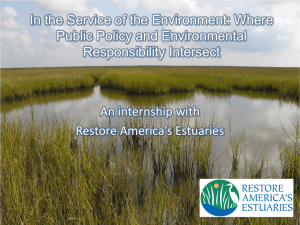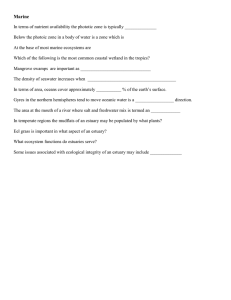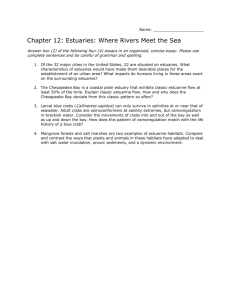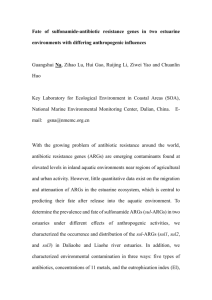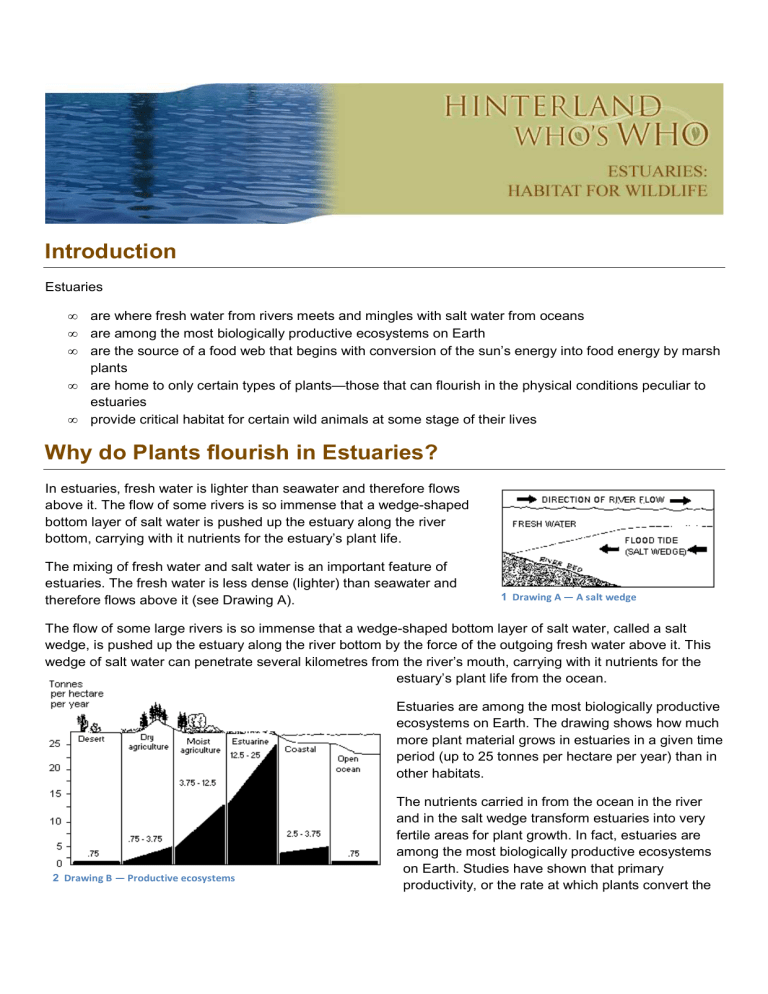
Introduction
Estuaries
•
•
•
•
•
are where fresh water from rivers meets and mingles with salt water from oceans
are among the most biologically productive ecosystems on Earth
are the source of a food web that begins with conversion of the sun’s energy into food energy by marsh
plants
are home to only certain types of plants—those that can flourish in the physical conditions peculiar to
estuaries
provide critical habitat for certain wild animals at some stage of their lives
Why do Plants flourish in Estuaries?
In estuaries, fresh water is lighter than seawater and therefore flows
above it. The flow of some rivers is so immense that a wedge-shaped
bottom layer of salt water is pushed up the estuary along the river
bottom, carrying with it nutrients for the estuary’s plant life.
The mixing of fresh water and salt water is an important feature of
estuaries. The fresh water is less dense (lighter) than seawater and
therefore flows above it (see Drawing A).
1 Drawing A — A salt wedge
The flow of some large rivers is so immense that a wedge-shaped bottom layer of salt water, called a salt
wedge, is pushed up the estuary along the river bottom by the force of the outgoing fresh water above it. This
wedge of salt water can penetrate several kilometres from the river’s mouth, carrying with it nutrients for the
estuary’s plant life from the ocean.
Estuaries are among the most biologically productive
ecosystems on Earth. The drawing shows how much
more plant material grows in estuaries in a given time
period (up to 25 tonnes per hectare per year) than in
other habitats.
2 Drawing B — Productive ecosystems
The nutrients carried in from the ocean in the river
and in the salt wedge transform estuaries into very
fertile areas for plant growth. In fact, estuaries are
among the most biologically productive ecosystems
on Earth. Studies have shown that primary
productivity, or the rate at which plants convert the
Estuaries: Habitat for Wildlife
sun’s energy by photosynthesis into food that animals can use, is higher in estuaries than in grasslands,
forests, and even areas of intensive agriculture (see Drawing B).
The Food Web
The basis of this estuarine food web is conversion
of the sun’s energy into food energy by marsh
plants. When the plants die and decay at the end
of the growing season, protozoa and other
microorganisms coat the dead plant material.
Small invertebrates, which feed on this detritus,
are themselves eaten by fish, which in turn may be
eaten by birds and mammals.
3 Drawing C — A food web
In the open ocean, microscopic algae known as
phytoplankton float in the sunlit surface waters and convert the sun’s energy to food energy. Phytoplankton
cannot grow in the muddy water of some estuaries, however. Instead, most of the primary production in these
estuaries is carried out by marsh plants, bottom-dwelling algae, and eelgrass that grow in abundance in the
marshes and mudflats (the muddy land that is left uncovered at low tide) that are part of estuaries. These
plants form the fuel of the estuarine food chain, which is the pattern in which plants are eaten by animals,
which are in turn eaten by other animals, transferring food energy in the process (see Drawing C). A variety of
different food chains then interconnect to form the estuarine food web.
Although one might guess that the next link in the food chain might be an animal feeding directly on the living
algae or eelgrass, in fact this is rarely the case in estuaries. There are only a few conspicuous herbivores, or
plant eaters, found in estuaries, and they are mainly waterfowl—like the Brant, a goose found in estuaries on
all three coasts of Canada, which feeds on eelgrass, certain species of ducks that eat the seeds of the marsh
plants, and the thousands of snow geese that gather in the Fraser and St. Lawrence river estuaries each
autumn to feed on bulrushes and sedges.
So what follows estuarine plants in the food chain? What happens is that the estuarine plants die at the end of
the growing season and decay gradually through fall and winter. The next step in the food chain is a rich
assortment of microscopic fungi, bacteria, protozoa, and other microorganisms, which coat the dead plant
material, called detritus (like a pile of rotting leaves or a compost heap). Small invertebrates, or animals without
a backbone, such as worms, snails, clams, oysters, and shrimp, feed on this detritus, becoming the next step
in the food chain. These invertebrates are then eaten by fish, amphibians, and birds, which in turn are eaten by
larger fish, birds, and mammals.
Evidence of this type of food chain can be found during a visit to any estuary. Bufflehead are often seen diving
in shallow water to find snails and other invertebrates living in soft estuarine sediments. In the Bay of Fundy
and at the mouth of the Fraser River, shorebirds gather in flocks exceeding 100 000 birds to probe the
mudflats with long bills in search of small invertebrates. Common Mergansers and Great Blue Herons find
Pacific and Atlantic estuaries especially attractive places to catch small fish. Sandpipers fall prey to Peregrine
Falcons that hunt along estuarine beaches, and Bald Eagles scavenge dead fish, birds, and mammals.
2
Estuaries: Habitat for Wildlife
The estuarine food chain would quickly fall apart without the tides. As the bacteria and other microorganisms
feed on the decaying plants, they use up much of the available oxygen in the water. This oxygen depletion
would make it difficult for the estuarine invertebrates and fish to breathe, and they would eventually suffocate.
However, regular incoming tides, occurring about every 12 hours, replenish the supply of oxygen for the
animals that feed in the estuaries, and the outgoing tides carry away their wastes, to be used elsewhere in the
estuary and nearby ocean.
Plants in Estuaries
Only certain types of plants can flourish in the physical
conditions peculiar to estuaries, and each of these plants
can grow in only certain parts of the estuary.
One factor influencing the growth and distribution of
plants in an estuary is its salinity, or the amount of salt in
the water. Certain kinds of plants can tolerate high levels
of salt, getting rid of the salt they take up by releasing it
through special salt pores on their leaf surfaces. Other
plants do not like even a moderate amount of salt and
can grow only in areas of the estuary where seawater
cannot reach. In between are plants that can tolerate
moderate amounts of salt and hence can survive in
brackish (or slightly salty) areas of the estuary.
4 Plants in estuaries: nature’s water garden
A second factor influencing the growth of plants in an estuary is the amount of flooding. The longer and deeper
an area is flooded with water, the less oxygen is available in the soil. As plant roots need oxygen to grow and
survive, the plants that grow in areas that are usually under water need to be adapted to an oxygen shortage,
some of them transporting oxygen from special storage cells in their leaves and stems to their roots.
One marine plant that flourishes in estuaries is eelgrass. This plant can tolerate only brief exposure to air and
therefore grows in large submerged beds near and below the lowest tide level. It is especially important as
food for American Wigeon and Brant. Plants that grow on land covered by seawater for brief periods each day
include salt-tolerant species such as the saltworts and saltgrasses on all three coasts, cordgrasses on the
Atlantic coast, and alkali grasses in the Arctic. Plants such as the sedge and bulrush predominate in brackish
areas of many estuaries, where they are covered by water for a few minutes to many hours each day. Areas
that are covered with fresh water support the cattail in profusion.
In fall and winter, most plants in all parts of the estuary decay and become detritus. Some plants, such as
algae, have a much shorter life cycle, lasting only a matter of days or weeks, and these continue to grow and
decay even in extremely cold weather.
3
Estuaries: Habitat for Wildlife
Animals in Estuaries
Few animals can live their entire lives in estuaries. However, estuaries are critical habitat for certain wild
animals at some stage of their lives. The few estuarine animal species that have adapted to the
characteristically changeable conditions of salinity, temperature, and water level found in these tidal areas
grow and multiply rapidly. Many other species, such as spawning whitefish and migrating sandpipers, move en
masse into estuaries at specific times of the year. In turn, the survival of predators, even those that rarely visit
estuaries, depends on populations of fish and birds that use these coastal ecosystems at key times in their life
cycles.
Mudflats, despite their desolate appearance, teem with invertebrates that burrow into the mud for protection
from predators and the elements. A variety of invertebrates, including mussels, clams, snails, amphipods, or
small shelled creatures, segmented worms, and lugworms, feast on detritus and each other in the mudflats and
fall prey to a multitude of fish and birds. For example, studies have recorded over 11 000 amphipods in one
square metre of mud in the Bay of Fundy during the southward migration of the Semipalmated Sandpiper.
These amphipods provide the necessary fuel for a million or more sandpipers to complete the nonstop flight of
about 4 000 km from the Bay of Fundy to Suriname in South America.
Marsh in the Fraser River estuary
Photo: R. Butler (CWS)
Snow geese in a Scirpus marsh in the St. Lawrence River estuary
Photo: A. Reed (CWS)
Belugas gather in large numbers within certain river estuaries during the summer ice-free season. Some
individuals are known to return to the same estuaries year after year.
4
Estuaries: Habitat for Wildlife
Resources
© Her Majesty the Queen in Right of Canada, represented by the Minister of the Environment, 1993. All rights
reserved.
Catalogue number CW69-47/88-1993E
ISBN 0-662-20448-4
Text: R.W. Butler, with assistance from N.K. Dawe, A. Reed, J. Sirois, and H. Blokpoel
5

